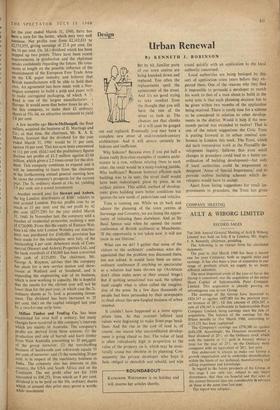Design
Urban Renewal
By KENNETH J. ROBINSON Why hideous? Because even if you put half a dozen really first-class examples of modern archi- tecture in a row, without relating them to each other, the result would be a nasty-looking jumble. Why inefficient? Because however efficient each building was to its user, the street itself would have been redeveloped, piece by piece, in an archaic pattern. This selfish method of develop- ment gives building users better conditions but ignores the new needs of pedestrians and vehicles.
Time is running out. While we sit back and admire the planning of the town centres at Stevenage and Coventry,,we are losing the oppor- tunity of imitating them elsewhere. And as Sir Basil Spence said when he opened the recent conference of British architects' at Manchester, 'lf the opportunity is not taken now, it will not recur in our lifetime.'
What can we do? I gather that some of the visitors to the architects' conference were dis- appointed that the problem was discussed there, but not solved. It would have been an extra- ordinary conference if anything so spectacular as a solution had been thrown up. (Architects don't often make news at their annual binge.) But if nothing sensational was said, the subject itself caught what is often called the imagina- tion of the press. In a few days thousands of people had been persuaded by their newspapers to think about this new-fangled business of urban renewal.
It couldn't have happened at a more appro- priate time. At that moment inflated land values were beginning to make front-page head- lines. And the rise in the cost of land is, of course, one reason why uncoordinated develop- ment is going ahead so fast. The value of land is often ridiculously high in proportion to the value of the property on it, which may be struc- turally sound but obsolete in its planning. Con- sequently the private developer who buys it feels obliged to demolish and rebuild, and nips round quickly with an application to the local authority concerned.
Local authorities are being besieged by this sort of application some years before they ex- pected them. One of the reasons why they find it impossible to persuade a developer to match his work to that of a man about to build in the same area is that each planning decision has to be given within two months of the application being received. There is rarely time for a scheme to be considered in relation to other develop- ments in the district. Would it help if the two- month period was extended to twelve? That is one of the minor suggestions the Civic Trust is putting forward at its urban renewal con- ference in London this week. The Trust, which did such tremendous work at the Piccadilly de- velopment inquiry, believes that even small changes in procedure could lead to a better co- ordination of building development—but only if local authorities could be empowered to designate 'Areas of Special Importance,' and to provide outline building schemes which de- velopers would have to accept.
Apart from listing suggestions for small im- provements in procedure, the Trust has given the top planning people at its conference three major proposals to consider. They are all based on the notion that comprehensive development, which includes replanning streets for cars and pedestrians, can only be properly carried out if all the land in the designated areas is under one ownership.
These are the three proposals: One. The local authority would purchase com- pulsorily all the land within the designated area and either lease or sell sites to private de- velopers, subject to their conforming to the authority's outline scheme. Or the authority would itself rebuild in the area and then lease or sell the completed buildings.
Two. Parliament would authorise the setting- up of Development Boards (like those for the New Towns) to acquire and develop designated areas. This would not only make for easier financial arrangements than the first proposal: it would also ensure 'the employment of expert architectural, planning and surveying staff, who are not available to the majority of local authorities.'
. Three. The local authority would purchase the designated area compulsorily, and then sell it to a private development company which would provide its own scheme, incorporating things like road improvements if the authority required them. This system would enable a private de- veloper, who could not normally afford such a venture, to get financial backing. And it would be more fair to the people whose land had been compulsorily purchased, because they could be offered an interest in the financial results of the project, as well as first refusal of new accom- modation.
These, then, are the principal points being considered at the conference, together with the Trust's important recommendation that 'there should be more effective co-ordination between transport and planning authorities at all levels.' (At present questions of planning and of traffic flow are rarely discussed in the same committee.) In time you will be able to get a report of the conference from The Civic Trust, at 79 Bucking- ham Palace Road, SWI. But I have a feeling that this is a conference which will result in much more than a nicely printed report and a
How long can he go on doing that, do you suppose?'
lot of inter-office back-slapping. The Civic Trust is not a crackpot organisation with more en- thusiasm than sense and money. It is very bright, quite nicely off, thank you, and very well con- nected, having the chairmanship of Duncan Sandys and the ear of his successor in the planning Ministry, Henry Brooke. It also has many other distinguished ears, and I'm con- vinced that they will be in good working order at the conference. Urban renewal presents problems that can be solved only by legislation• If we don't get legislation, someone will have to work hard to think of a good reason why not. I look forward to not having to report the reason







































 Previous page
Previous page